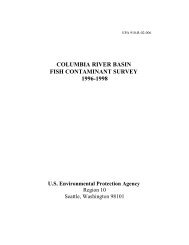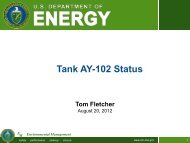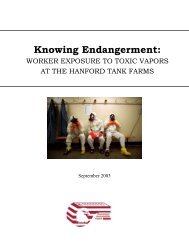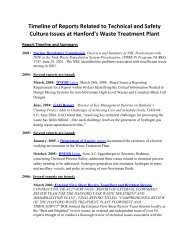Reducing the Risks of High-Level Radioactive Wastes at Hanford
Reducing the Risks of High-Level Radioactive Wastes at Hanford
Reducing the Risks of High-Level Radioactive Wastes at Hanford
Create successful ePaper yourself
Turn your PDF publications into a flip-book with our unique Google optimized e-Paper software.
68 Alvarez<br />
NRC regul<strong>at</strong>ion <strong>of</strong> <strong>the</strong> vitrific<strong>at</strong>ion plant would fall under 10 CFR Part 70<br />
which governs nuclear fuel cycle facilities;<br />
<br />
<br />
The contractor would hold <strong>the</strong> license and DOE would not be subject to direct<br />
NRC fee assessment; and<br />
The certific<strong>at</strong>ion <strong>of</strong> high-level waste storage tanks would be licensed under<br />
10 CFR Part 76, because <strong>the</strong>se are existing facilities being certified ra<strong>the</strong>r<br />
than licensed.<br />
NRC has estim<strong>at</strong>ed th<strong>at</strong> 32 full time staff equivalents would be required<br />
to carry out <strong>the</strong> work, which corresponds to $8 million per year. These costs<br />
are required to be recovered by charges levied on <strong>the</strong> licensee. Since NRC has<br />
already developed regul<strong>at</strong>ions and guidance, <strong>the</strong> annual costs may be lower for<br />
regul<strong>at</strong>ory transition. Moreover, <strong>the</strong> total costs <strong>of</strong> NRC regul<strong>at</strong>ion are a small<br />
portion—less than half <strong>of</strong> one percent—<strong>of</strong> <strong>the</strong> total program cost.<br />
REDUCING ON-SITE DISPOSAL RISKS<br />
DOE’s efforts to dispose <strong>of</strong> substantially larger quantities <strong>of</strong> radionucides onsite<br />
from high-level wastes are premised on establishing “risk-based end st<strong>at</strong>es.”<br />
Modeling <strong>of</strong> <strong>the</strong> n<strong>at</strong>ural <strong>at</strong>tenu<strong>at</strong>ion <strong>of</strong> radionuclides over periods <strong>of</strong> hundreds<br />
to thousands <strong>of</strong> years is a limited approach th<strong>at</strong> does not factor in:<br />
dram<strong>at</strong>ic shrinkage <strong>of</strong> controlled areas <strong>at</strong> <strong>the</strong> <strong>Hanford</strong> site within eight<br />
years,<br />
accident scenarios involving <strong>the</strong> processing <strong>of</strong> high-level wastes,<br />
<strong>the</strong> high existing vulnerability <strong>of</strong> tribal people to environmental contaminants,<br />
and<br />
integr<strong>at</strong>ion <strong>of</strong> n<strong>at</strong>ural resource risks with human health risks.<br />
Over coming years, DOE plans to lift radiological controls over large sw<strong>at</strong>hs<br />
<strong>of</strong> <strong>the</strong> <strong>Hanford</strong> site for transfer to <strong>the</strong> U.S. Interior department’s Fish and<br />
Wildlife Service. The transfer is intended to reduce DOE overhead expenses,<br />
while expanding <strong>the</strong> <strong>Hanford</strong> Reach N<strong>at</strong>ional Monument. 140 More than 87 percent<br />
<strong>of</strong> <strong>the</strong> land DOE currently occupies will be shifted to Interior, by 2012 opening<br />
public access for thousands <strong>of</strong> people. 141 Even though potential vitrific<strong>at</strong>ion<br />
accidents “show a significant distance effect,” 142 DOE’s assumes th<strong>at</strong> <strong>Hanford</strong>’s<br />
current security perimeter <strong>of</strong> 6.8 to 9.3 miles (11,000 to 15,000 meters), will<br />
indefinitely serve as <strong>the</strong> boundary for public exposures. 143 To be more protective,<br />
NRC’s guidance, which sets <strong>the</strong> public dose, including colloc<strong>at</strong>ed workers,<br />
<strong>at</strong> <strong>the</strong> “fence line” <strong>of</strong> 100 meters should be adopted. 144<br />
Underscoring <strong>the</strong> need for public health conserv<strong>at</strong>ism is recent evidence indic<strong>at</strong>ing<br />
th<strong>at</strong> tribal people living near <strong>Hanford</strong> are <strong>the</strong> most vulnerable to harm







